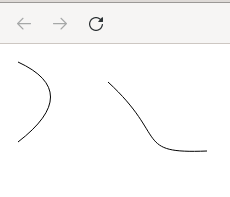Bézier Curves in Canvas
It is possible to draw Bézier curves onto the canvas. To achieve this, we need to call the two methods related to drawing Bézier curves, namely: quadraticCurveTo() and bezierCurveTo().
- quadraticCurveTo(cpx, cpy, epx, epy)
This method requires four arguments:
- cpx: the x-axis coordinate of the control point.
- cpy: the y-axis coordinate of the control point.
- epx: the x-axis coordinate of the end point.
- epy: the y-axis coordinate of the end point.
The starting point may be the latest point in the current path or it may be changed using the method moveTo().
index.js
const canvas = document.getElementById("canvas")
const context = canvas.getContext("2d")
context.beginPath()
context.moveTo(10, 10) // Coordinates of the starting point (10, 10)
/*
Coordinates of the control point (75, 40) and
coordinates of the end point (10, 90)
*/
context.quadraticCurveTo(75, 40, 10, 90)
context.stroke() // stroke() must be called to draw the curve

- bezierCurveTo(cp1x, cp1y, cp2x, cp2y, epx, epy)
This cubic Bézier curve drawing method is similar to the previous one, except that two control points are required instead of one.
- cp1x: the x-axis coordinate of the first control point.
- cp1y: the y-axis coordinate of the first control point.
- cp2x: the x-axis coordinate of the second control point.
- cp2y: the y-axis coordinate of the second control point.
- epx: the x-axis coordinate of the end point.
- epy: the y-axis coordinate of the end point.
context.beginPath()
context.moveTo(100, 30)
context.bezierCurveTo(160, 85, 126, 102, 199, 99)
context.stroke()

There is a very interesting video on YouTube by Freya Holmér explaining the mathematics behind the Bézier curves: The Beauty of Bézier Curves